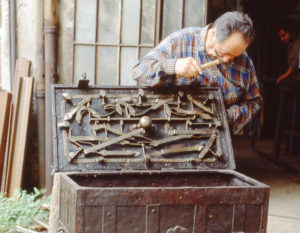The Blacksmith’s Feet:
Embodied Entextualization in Northern Italian Vernacular Poetry
by Jillian R. Cavanaugh
The essay begins:
How does one know if poetry is good? While there are many ways to answer this question, and as many arguments arising in response to each answer, here I take a linguistic anthropological approach to discuss the production and evaluation of good poetry and good poets—specifically vernacular poetry and poets—as social and cultural processes. I want to undertake, in other words, a cultural poetics or ethnopoetics, explicating a culturally specific structure of evaluation that depends on local understandings, practices, and values. Such projects have a long history in anthropology, at least since Franz Boas’s Introduction to the Handbook of American Indian Languages, which included an investigation of poetry as part of anthropological inquiry, and Edward Sapir’s writing on the anthropological importance of portraying a group’s aesthetics, or their “feel” for the rightness or wrongness of fit of form to function. To consider poetry as a social practice is to consider the local aesthetics within which such poetry comes into being, is evaluated, and circulates. As such, it necessarily means to consider the social positioning of genres as well as social groups, since any local aesthetic practices and standards are built upon connections across genres, environments, texts, speaking contexts, types of speakers and listeners, and modes of evaluation particular to a group.
This analysis focuses on the particular connections that are grounded in bodies, the bodies that appear in poetry and the bodies that produce poetry, as well as how these two categories may or may not align. Briefly, bodies enter into and engage with texts—they write, perform, evaluate, and listen to them—in culturally specific ways that are the intertwined processes of embodied entextualization. How bodies and texts are connected is embedded within local aesthetic systems, such that evaluations of good and bad poetry will at least in part be based on which bodies produce and encounter texts, how bodies are portrayed in texts, and how these two categories may or may not align with each other as well as with culturally specific aesthetic standards about bodies. Continue reading …
 Vernacular poetry is generally evaluated according to culturally specific aesthetic standards, what anthropologists call ethnopoetics. This article offers embodied entexualization—the culturally specific ways bodies are incorporated into as well as produce texts—as a means for analyzing how ethnopoetic systems reflect social and political histories and contexts. The poetry of the northern Italian town of Bergamo, and specifically a poem by a locally celebrated poet, Piero Frér, provides an illustrative case.
Vernacular poetry is generally evaluated according to culturally specific aesthetic standards, what anthropologists call ethnopoetics. This article offers embodied entexualization—the culturally specific ways bodies are incorporated into as well as produce texts—as a means for analyzing how ethnopoetic systems reflect social and political histories and contexts. The poetry of the northern Italian town of Bergamo, and specifically a poem by a locally celebrated poet, Piero Frér, provides an illustrative case.
JILLIAN R. CAVANAUGH is Leonard and Claire Tow Research Professor at Brooklyn College and the Graduate Center, CUNY. She is a linguistic anthropologist whose research centers on language, food, value, and the construction of meaning.
